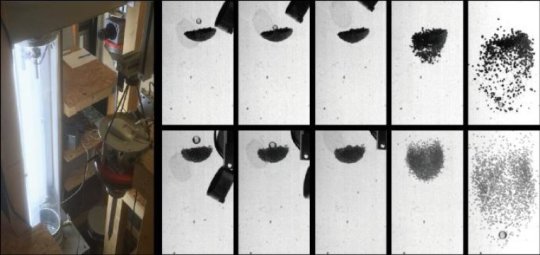[ad_1]
Everybody is familiar with granular clusters — while making a cake in the kitchen, you see that the flour forms clumps. Porous dust agglomerates — clumps of clumps of dust grains — are considered to be building materials in the formation of planets. But to reveal how planets are formed, the physical behaviour of these dust clumps has to be properly understood. In particular, their response when hit by projectiles is key because the conditions causing impact-induced sticking, bouncing, fracturing, and so on, must be known in order to establish a plausible planetary-formation model. Since the porous dust agglomerates can be regarded as granular matter, the basic physical properties of granular matter are crucial for constructing the model. One approach to learning about granular impact dynamics relating to the planetary formation process is by direct observation — that is, carrying out experiments on Earth that simulate the space environment.
Hiroaki Katsuragi, a granular physics expert from Nagoya University, and Jürgen Blum of the Technische Universität Braunschweig have done just that. Blum has constructed a drop tower where microgravity and vacuum conditions are achieved to mimic the environment in space. They fired various kinds of projectiles — plastic, lead, glass — of varying sizes at clumps of dust — which are soft and fragile — as well as at loose, dense clumps of relatively rigid glass beads. The team then carefully analyzed the impact-induced expansion and found evidence for universal energy transfer and dissipation scaling laws. In addition, the team found that the scaling laws are applicable not only to the porous agglomerate clusters but also to the dense glass-bead clusters.
Katsuragi, explains: “The result is useful to deeply understand the planet-formation process. At the same time, we are surprised at the agreement of the expansion dynamics between porous (fragile) clusters and dense (rigid) clusters. Actually, the porous clusters consist of tiny grains of powder clumped together, and these clusters of many sizes are themselves clustered together. We found that this type of hierarchical structure does not affect the impact-induced dynamics.”
This study links the physics of planetary formation and clump formation through the microgravity experiment. The drop tower used in the study is unique in that short-duration impact experiments can readily be repeated at low cost. The interdisciplinary collaboration team is also unique. Hiroaki Katsuragi is a granular physicist and Jürgen Blum is a planetary physicist and both share the common goal of understanding the impact of porous and dense granular matter.
Katsuragi notes finally, “We’re all familiar with clumps of powder: they’re formed whenever we make a cake with flour. Nevertheless, the physics of clumps — of hierarchical granular matter — has not been studied well so far. This study could open up a novel research direction in the physics of granular matter.”
Story Source:
Materials provided by Nagoya University. Note: Content may be edited for style and length.
[ad_2]















